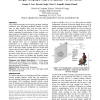Free Online Productivity Tools
i2Speak
i2Symbol
i2OCR
iTex2Img
iWeb2Print
iWeb2Shot
i2Type
iPdf2Split
iPdf2Merge
i2Bopomofo
i2Arabic
i2Style
i2Image
i2PDF
iLatex2Rtf
Sci2ools
75
Voted
CHI
2003
ACM
2003
ACM
With similar visual angles, larger displays improve spatial performance
Large wall-sized displays are becoming prevalent. Although researchers have articulated qualitative benefits of group work on large displays, little work has been done to quantify the benefits for individual users. We ran two studies comparing the performance of users working on a large projected wall display to that of users working on a standard desktop monitor. In these studies, we held the visual angle constant by adjusting the viewing distance to each of the displays. Results from the first study indicate that although there was no significant difference in performance on a reading comprehension task, users performed about 26% better on a spatial orientation task done on the large display. Results from the second study suggest that the large display affords a greater sense of presence, allowing users to treat the spatial task as an egocentric rather than an exocentric rotation. We discuss future work to extend our findings and formulate design principles for computer interfaces a...
CHI 2003 | Human Computer Interaction | Large Display Affords | Large Wall-sized Displays | Spatial Orientation Task |
Related Content
| Added | 01 Dec 2009 |
| Updated | 01 Dec 2009 |
| Type | Conference |
| Year | 2003 |
| Where | CHI |
| Authors | Desney S. Tan, Darren Gergle, Peter Scupelli, Randy Pausch |
Comments (0)

